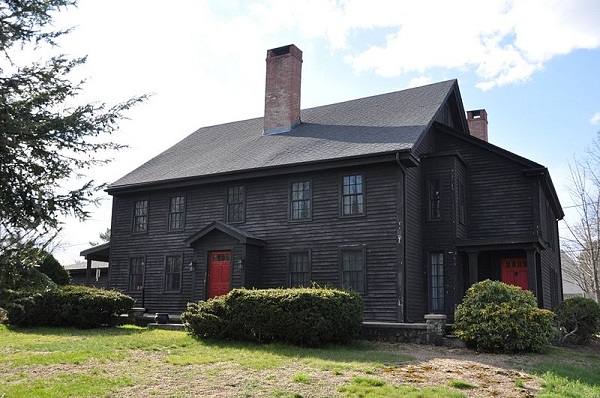The John Proctor House is a historic First Period colonial in Peabody, Massachusetts on a farm where Salem Witch Trials victim John Proctor lived.
The home is a two-story first period house about 3,900 square feet in size with six bedrooms, seven fireplaces, an eat-in kitchen, two baths and an in ground swimming pool.
Though a white plaque on the home reads “1638 John Proctor House,” it is debatable whether John Proctor actually lived in the house, with most historians stating that he most likely did not, but he may have lived in an earlier house on the same spot.

In a 2018 interview with Boston.com, Kelly Daniell of the Peabody Historical Society explained that while the house does sits on the land Proctor and his family farmed, the current house could have part of the original home inside or may have been rebuilt on the original foundation of an earlier house.
History of the John Proctor House:
The property that the house sits on was first awarded to colonist Robert Cole on December 21, 1635. Cole then sold it to Emmanuel Downing on July 16, 1638.
Downing named the estate “Groton” and built a house on the property soon after but it was destroyed in a fire, on August 2, 1645, after the chimney caught fire while Downing and his family were at church.
Downing most likely built another house and then later leased the farm out to several tenants over the years. William Flint leased it in 1648 and his son, Thomas Flint, leased it from 1649 to 1658.
In 1666, Downing leased about 300 acres of the 700-acre farm to John Proctor, who lived on the property and farmed the land with his family up until his execution during the Salem Witch Trials in 1692.

There is a possibility that John Proctor may have even been buried on the property after his death in 1692 but it is not known for certain.
After John Proctor was executed, Benjamin Preston leased the farm. It’s not clear how long Preston leased it for but sometime after that John Proctor’s son, Benjamin, began to lease it.
Then on September 13, 1700, Benjamin’s brother Thorndike bought the property from Emmanuel Downing’s grandson, Charles Downing. Thorndike later sold a portion of the farm to his brother Benjamin.
It is believed that Thorndike Proctor built the house sometime around 1727, according to a September 2017 dendrochronology report by architectural conservator William “Bill” Flynt.
In an interview with the Salem News in 2018, Kelly Daniell of the Peabody Historical Society stated that she discovered records of the purchase of building materials, including nails, shingles, and wood, in the accounting book of Thorndike Proctor in the time period around 1726 and 1727, which backs up the dendrochronology report.
The house remained in the Proctor family well into mid-to-late 19th century before being sold to someone outside the family. After that the house changed owners only a number of times.
In April of 1968, Vincent Raponi, purchased the home and lived in it with his wife and family for nearly 50 years.
In an interview with the Salem News in 2018, Rosanne Bakos, daughter of Vincent and Marion Raponi, stated that the house had sat vacant for nearly a year and a half before her father drove past it one day in 1968, saw the for sale sign and decided to buy it.
On March 9, 1990, the house was listed on the National Register of Historic Places.
After Marion Raponi died on October 8, 2018, at the age of 90, the house was put for sale.
In December of 2018, Barbara Bridgewater and her husband, Christopher Mendez, of Huntington Beach, California, purchased the house for $600,000 after a first buyer fell out of escrow.
The family plans to use it as a vacation home and may possibly open it up to the public for tours when not in use.
The John Proctor House is located at 348 Lowell Street, Peabody, Mass.
Sources:
Essex Institute Historical Collections. Vol LI – 1915, Essex Institute 1915.
Tapley, Harriet Silvester. Historical Collections of the Danvers Historical Society, Vol. 9, Danvers Historical Society, 1915.
Lang, Cady. “Just In Time for Spooky Season, You Can Be the Proud Owner of a Famous Salem Witch Trials Victim’s House.” Time Magazine, 15 Oct. 2018, time.com/5424718/john-proctor-house/
“John Proctor House.” Salem Witch Museum, salemwitchmuseum.com/locations/john-proctor-house/
Bilis, Madeline. “On The Market: A Home With Ties to the Salem Witch Trials.” Boston Magazine, 11 Oct. 2018, www.bostonmagazine.com/property/2018/10/11/proctor-house-salem-witch-trials/
MacNeill, Ariana. “A Home With Some Salem Witch Trials History Is Up For Sale.” Real Estate, 10 Oct. 2018, realestate.boston.com/news/2018/10/10/john-proctor-house-peabody-for-sale/
Romano, Andrea. “The Home of Salem Witch Trials Victim John Proctor Is For Sale.” Travel and Leisure, 17 Oct. 2018, www.travelandleisure.com/travel-news/john-proctor-witch-trial-victim-house-for-sale
Bode, Kelsey. “Preserving History: California Family Buys John Proctor House.” Salem News, 27 Dec. 2018, salemnews.com/news/local_news/preserving-history-california-family-buys-john-proctor-house/article_ab0370af-6f1e-5d35-9d66-c82330e65d09.html
Bode, Kelsey. “Historians, Proctor House Owners to Preserve True History of Life After Trials.” Salem News, 3 Jan. 2019, salemnews.com/news/local_news/historians-proctor-house-owners-to-preserve-true-history-of-life/article_aa669619-d7bf-54b9-b334-8a445b542fc4.html
“John Proctor House.” Salem Witch Museum, salemwitchmuseum.com/locations/john-proctor-house/
Benton, Nelson. “Benton: Bonfanti Focuses on Proctor Farm.” Salem News, 11 Oct. 2018, salemnews.com/opinion/columns/benton-bonfanti-focuses-on-proctor-farm/article_dd45756d-bddb-5831-8049-9976d3e4ddef.html
Upham, William P. House of John Proctor: Witchcraft Martyr, 1692. Peabody Historical Society, 1904., www.gutenberg.org/files/27386/27386-h/27386-h.htm
